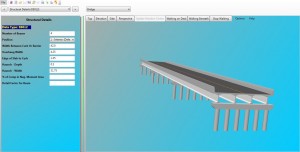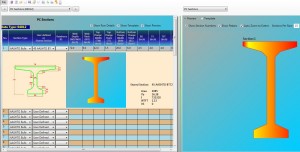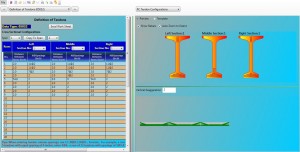Design, Analysis and Rating of Prestress Concrete Bridge Girders
Download
❯ USER MANUAL
❯ LATEST RELEASE NOTES
❯ TUTORIAL – SIMPLE SPAN
❯ TUTORIAL – 3-SPAN
Abstract
The prestressed precast concrete girder analysis and design program, DASH/P, is a submodule of the popular MERLIN-DASH program and will perform a complete analysis and code check of simple-span and multi-span prestressed highway bridges, in accordance with the latest AASHTO Standard and LRFD specifications. The DASH/P design system contains features generalized to a level which allows universal usage. The program is accessed through a user-friendly preprocessor for data preparation and executed by using the latest numerical analysis techniques to accommodate general usage of strand patterns, arbitrary loadings, and user-defined girder members. The program will compute and print the results in tabular form for any defined points along the span for the following: Section properties for composite and non-composite; dead load and live load reactions; shears, moments, and displacements; stresses for various construction stages; prestressing losses and forces; ultimate moments provided and required; and cracking moments.
Program Scope
A full range of features which allow for the most general usage have been incorporated into DASH/P. The basic capabilities of the system are summarized in Table 1. Specific features apply to applicable specifications, loadings, and structural configurations.
Specifications: Prestressed girder bridges are modeled, analyzed, and code-checked in accordance with the latest AASHTO specifications.
Structural Configuration: A number of features are available in DASH/P which allow analysis of various structural bridge configurations. A summary of those features is given in Table 2. Further, since DASH/P is matrix-based and modular, it is easily upgradable for incorporation of other features.
Dead Load: The program is capable of automatically generating all DL calculations in accordance with AASHTO for both composite and non-composite construction stages. Specifications are:
- All dead load conditions are investigated automatically for various construction stages;
- Special concentrated or uniform loads are available at the option of the user;
- Prestressed tendon forces are converted automatically to equivalent joint loads inside the computer program.
Live Loads: Incorporated with the DASH/P system is a most general and wide range of live load capabilities with the utilization of influence lines, as follows:
- Standard AASHTO truck and lane loadings;
- Interstate or military vehicles;
- Non-standard AASHTO loadings (HS-25);
- HL-93 for AASHTO LRFD Specifications;
- Generalized 20-axle (user-defined) arbitrary trucks;
- Application of all truck loadings in both directions;
- Impact factors for moments, shears, displacements, and reactions can be defined by user; otherwise, they are computed internally in accordance with AASHTO specifications;
- Distribution factors can be defined by user, or default to the AASHTO Standard or LRFD specifications.
The methodology incorporated with the live load portion of DASH/P was developed to be most generally applicable. Determination of all maxima is accomplished by utilization of influence lines. The influence lines were developed by placing unit loads at any user-defined point along the girder.
Limitations: DASH/P, developed with use of the most modern programming techniques, has almost no size limitations. Program size can be adjusted by changing only a couple of variables in the dynamic memory system (only the sponsor of the program has the key to modify the size).
Summary of General Features
- Full Analysis Capability
- Full Code Check Capability With All AASHTO Provisions
- Very Rapid Processing
- Most Design Parameters May Be Overriden by User
- Generalized AASHTO and Truck Live Loading
- Generalized Truck Configurations Specified by User
- Generalized Girder Configurations
- Generalized Tendon Configurations
- Generalized Dead Load Configurations
- Prestressed Beam Composite or Non-composite
- Analysis Based upon the Stiffness Method
- Prismatic Sections
- AASHTO Prestress Losses
- Hinges for Construction Stages
- AASHTO Sections (Built-in)
- Completely Modular and Easily Modifiable System
- Indexed Tabular Output
- WINDOWS, or WINDOWS/Network environments available
Structural Configuration Summary
- Simple Spans (Singly, or in Series)
- Continuous Spans
- Hinges (Moment Release) at Any Location
- Prismatic or Stepped Prismatic
- Standard AASHTO Section
- AASHTO Lookalike Section
- Bulbtee Section
- Slab Section
- Box Section
- PCEF Section
- User Supplied Section File


